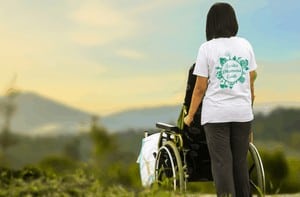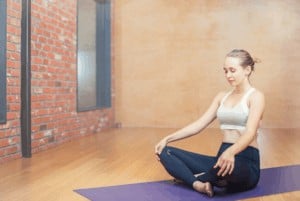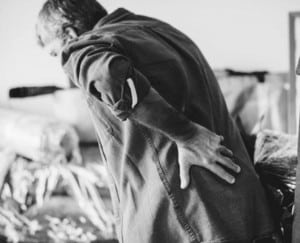We hope you love the product we recommend! Just so you know, at no extra cost to you, we may get a small commission for purchases made through links in this post. Your support is appreciated. Enjoy the read!
Wondering the difference between Daydreaming vs Night Dreaming?
Wonder no more; we got the answers here!
In the same breath, learn how to:
- Increase your chances of lucid dreaming with strengthening your dream recall
- Achieve proper Positive Constructive Daydreaming (PCD)
- Interpret the meaning behind 8 most common dreams
What Are Dreams?
Have you ever experienced a dream so life-like that it makes you question reality?
Ask people to describe it, and you will come across words such as surreal, incredible, and mindblowing, all the way to downright scary.
For years, scientists have been digging deep into this concept: ‘what are dreams?’.
The simple answer is – it’s the imagination of your subconscious, which comes to life when you sleep.
It tends to occur in the last stage of the sleep cycle, known as rapid eye movement (REM).
A lot of people claim that they never dream, but the truth is that they just don’t remember their dreams.
Why Do We Dream?
Okay, now you know what it is, the next question is, why does it happen every single night without fail?
While humanity is making great strides in medicine, psychology, and other areas, scientists still can’t explain why you dream.
Of course, there are plenty of theories that try to explain this activity, like the following ones:
- Activation-synthesis hypothesis
The belief is that it’s your brain’s electrical impulses. Sigmund Freud, the world-renowned psychologist, states that they are repressed conflicts you have experienced in your life. - Threat simulation theory
This theory claims that your body is preparing you to face dangerous events in a safe and secure manner. - Unconscious and repressed desires
Sigmund Freud also speculates that the reason why people dream is due to the unconscious and repressed wishes that remain in their minds.
As you can see, there are many hypotheses as to why we dream. Researchers just haven’t been able to prove it yet.
Daydreaming vs Night Dreaming
Most people are familiar with night dreams – the ones that occur after you go to bed.
If you were to wake up in the middle of the experience, you would recall illogical and bizarre stories, which may or may not make sense to you.
Daydreaming is also quite a common phenomenon.
Do you remember the time when you let your mind wander and ended up in a different world?
You can think of it as a way to focus more on your internal world and pay less attention to the external one.
What Does Daydreaming Mean?
 According to scientists, the reason why you daydream is because of the default network in your brain.
According to scientists, the reason why you daydream is because of the default network in your brain.
It links the multiple cortical areas, limbic system, and frontal cortex.
In other words, any part of your body involved in creating sensory experiences is part of this network.
When it’s active, these components start to create their stimulation, known as stimulus-independent thought.
It’s a fancy term for experiences such as fantasies that come to life when you let your mind wander.
Daydreaming tends to occur when you think of something that can take place in the future or when you try to relive the past.
It gives you the opportunity to take a look at things from a different perspective.
When used correctly, it can be advantageous, as it has the power to bring significant amounts of happiness to your life.
Daydreaming can help solve the majority of problems you face and focus on the right things.
A study conducted by Micheal Kane and his colleagues tracked daydreaming among 274 college students for a week.
The researchers discovered that this activity could be positive, as long as the content and context meets the current or future circumstances.
They observed that students became anxious when their minds wandered during the tests.
The reason was that they were thinking about the problems, instead of focusing on completing the task.
On the other hand, the other participants, who daydreamed frequently during their regular lives, didn’t fall into the same boat.
As they were dreaming when allowed, it became easier for them to focus on the task (the test in this case) at hand.
How to Daydream Vividly
 Now that you know you can use daydreaming to your advantage, the next step is to understand how to do it properly.
Now that you know you can use daydreaming to your advantage, the next step is to understand how to do it properly.
The aim is to achieve Positive Constructive Daydreaming (PCD), which enhances your creativity and self-awareness.
With PCD, you can give your mind a break, which, in turn, allows you to prepare and be ready for what’s to come in the future.
You can think of it as a way to let your mind wander, but on a leash.
If you go too far, the act of benefiting from daydreaming is lost.
Guide for Positive Constructive Daydreaming (PCD)
- Plan: when you would like to daydream and about what. Although it seems counterintuitive, it can help prevent any disappointment which may arise when you indulge in this activity.
- Perform small, effortless activities
As your mind drifts, doodling, cloud-watching, or walking are good choices, but any activity that doesn’t take a lot of attention will do. - Let yourself go: Just imagination go and just observe
Keep in mind that your brain might resist creative thoughts.
The trick is to relax and let your mind play everything out.
- Pay attention to what’s going on inside of you
- Take note of what you’re experiencing internally – What are your thoughts? What do you see? How do you feel?
If you find this challenging, shift to a relaxing position, such as staring out of a window or sitting on a comfortable chair.
The Meaning of 8 Common Dreams
Although dreams tend to be unique, there are certain patterns that are more common.
Here are eight typical themes along with their meaning:
Being Chased
Have you ever dreamt that something or someone was chasing you?The experience is terrifying, as it feels like you can never get away.
According to experts, it’s an indicator that you want to escape from your desires or fears.
Death or Dying
 If you die or see someone dying, especially a loved one, it can mean that you fear the unknown.
If you die or see someone dying, especially a loved one, it can mean that you fear the unknown.Sometimes, it can be about sudden changes, such as your children leaving the house to attend college.
Falling
Falling, especially spiraling into darkness, can indicate that you feel like you’re losing control over things in life – whether it’s your finances, relationships, or job.In reality, you need to let go and enjoy what life has to offer.
Perhaps, you can try going in a different direction and see how things turn out.
Flying
Flying is an incredible experience to have in your dream.
If it’s an integral part of your fantasy, it indicates that you are happy with your life.
On the flip side, it can also refer to your desire to escape or run away from your responsibilities.
Infidelity
It’s quite stressful when you see your partner ‘cheat’ on you in your dream.
The majority of people may start to believe that infidelity will happen in the future.
However, it’s more of a subconscious reflection of underlying problems in your relationship that you need to address.
Losing Teeth
 Any dream which involves the loss of teeth can mean several things.
Any dream which involves the loss of teeth can mean several things.Some experts believe it’s an indicator that you are undertaking significant stress, as you are unable to communicate properly.
Others believe it’s a sign which shows that you think that you are not as attractive as you look.
Being Naked
If you were in a dream where you ended up naked in a public setting, don’t sweat it – it’s quite normal.
Your subconscious mind is trying to highlight insecurity, vulnerability, shame, or humiliation.
Taking Tests
As a student, it makes sense to dream about writing exams, as it causes a lot of stress.
However, if you graduated several years ago, then it refers to your job.
There’s pressure from work, and you have a fear that things may not go well.
Do Blind People Dream?
Did you know that blind people also have the ability to dream in their sleep?
A recent study evaluated REM stages among candidates who suffered from congenital blindness.
Even people who become blind at later stages of their lives have dreams.
However, the amount of imagery is lower, when compared to those with sight.
Researchers discovered that visual imagery is possible, despite the disability.
The dreams are along the same lines as the ones that sighted people experience.
Those with congenital blindness are more likely to experience dreams via touch, smell, sound, and taste.
However, people tend to have a lower number of images the longer they lead their lives without sight.
Do Men and Women Dream Differently?
According to one study, men and women tend to have different dreams.
The experiences among both genders vary in length and content.
For example, men are more likely to dream about weapons, while it’s clothing for women.
Similarly, both sexes appear in the imagination of females, while the same gender is twice as likely to appear among males.
Do Animals Dream?
Yes! Whenever you see your cat or dog moving in its sleep, it means they’re having a full-on dream!
This study proves that most, if not all, animals can have this type of experience.
Lucid Dreaming – What Is It?
Did you know that it’s possible for you to be in complete control of your dreams? It’s a combination of REM sleep and consciousness.
Although you may not be able to bend your experience like in the movie “Inception,” there are a lot of things you can do – basically, do anything you want in your dream.
There are widely accepted methods to induce lucid dreaming like the MILD or WILD technique, but the first step is getting better at remembering your dreams.
8 Tips to Strengthen Dream Recall
A lot of people find it challenging to remember their dreams. If you are also on the same boat, don’t worry, as you can overcome them with these tips:
1. Avoid using an alarm
Setting the alarm is essential if you want to wake up and go to work on time. However, when the goal is to recall your dreams, you should avoid using one.
The reason is that it disrupts the focus of your brain, making it harder to recollect the details.
2. Don’t change position after waking up
 When you wake up from deep sleep, make it a point to not change your position.
When you wake up from deep sleep, make it a point to not change your position.
You should avoid thinking about what you have to do for the day too.
3. Ensure you get adequate amounts of sleep
It’s crucial that you sleep for at least 7-9 hours each night.
Getting enough rest plays a huge factor in your ability to remember details.
4. Go to bed at the same time
The trick is to sleep at a fixed time every night so that it becomes habitual.
A routine trains your body and brain to do certain things (like sleeping) at a certain time without resistance.
5. Maintain a dream journal
 One good tip which will help in dream recall is to keep a dream journal.
One good tip which will help in dream recall is to keep a dream journal.
As soon as you wake up, make a note of everything you have experienced in your sleep.
6. Pay attention to what you consume
The type of food you eat will impact your ability to remember dreams.
For instance, if you have a cup of coffee right before you hit the bed, it changes the quality of sleep.
As a result, it becomes harder to slip into the REM stage and recall your dream.
7. Set intentions to remember your dream
You should make it a point to let yourself know that you have to remember your dreams.
Once it enters your subconscious, it won’t be long before you can recollect all the details.
8. Think about it as soon as you wake up
The moment you open your eyes, you should start thinking about the dream right away.
As the experience is fresh, the chances of remembering everything is higher.
Daydreaming vs. Night Dreaming FAQ
Haven’t gotten enough of Daydreaming vs Night Dreaming yet?
Check out the FAQ that we got answers to!
Why do we dream?
The reason why we daydream is because of the lack of interest in the current situation.
Some thoughts tend to be about the goals you want to achieve. It’s a form of reflection.
What is the difference between daydreaming and night dreaming?
The difference between daydreaming and night dreaming is ‘when’ it takes place.
The former tends to occur when you are awake.
On the other hand, night dreaming is due to REM, which is responsible for the experience.
Keep in mind that for the latter, you are not awake, which is the differentiating factor.
Also, there is complete immersion when it comes to night dreaming, as you switch off from the real world.
What does daydreaming do to your brain? Is saydreaming a symptom of ADHD, a coping mechanism, or a form of dissociation?
Daydreaming takes place because your brain activates its default network.
As a result, all the thoughts in your subconscious mind start to appear in front of you.
Daydreaming may be a symptom of ADHD if you are unable to get back to reality easily.
In most cases, it’s a form of dissociation or coping mechanism due to the lack of interest in your present reality.
Does daydreaming have a purpose? How do you daydream on purpose?
Daydreaming does have a purpose – it can be a form of self-reflection.
To make the most of daydreaming, you can follow this guide:
- Plan beforehand about what you’d like to reflect on.
- Perform light activity like doodling or walking so your mind can drift.
- Let your imagination do its thing and just observe where it goes.
- Take note of what you’re experiencing internally – What are your thoughts? What do you see? How do you feel?
Do blind people dream?
Yes, blind people can have vivid dreams, despite their disability.
Even congenitally blind subjects can experience the same.
If the person becomes blind during a later stage of their life, they will still dream in color.
The reason is that they still remember all the details before they lost their sight.
What are the different types of dreams?
There are many different types of dreams, but here are the eight most common ones.
The meaning of these dreams can be found in the section above.
- Being chased
- Death or dying
- Falling
- Flying
- Infidelity
- Loss of teeth
- Naked
- Writing exams
What is the difference between lucid and vivid dreams?
There is a significant difference between lucid and vivid dreams.
In the latter, you will experience complete color, smells, touch, and pain, along with other types of sensory information.
However, you don’t have a clue that you are in a dream.
On the other hand, lucid dreams mean you have complete control.
You can do or experience anything you want in your dream.
For instance, you can make things appear out of thin air.
Do dreams mean anything?
Yes, dreams do have a lot of meaning, as it’s your subconscious mind which becomes active during this period.
Although it’s up to interpretation, the central theme of the experience will explain the meaning.
For example, when you have a dream of someone chasing you, it indicates that you are running away from your fears.
Why am I dreaming so much all of a sudden?
The reason why you are dreaming so much all of a sudden depends on several factors.
For example, stress, specific medications, illicit drugs, and sleep deprivation can cause a significant increase.
If you suffer from sleep apnea, a sleep disorder, the number of dreams will rise too.
How long do dreams last?
On average, your dream should last for two hours every night.
Hope you enjoyed learning about the difference between Daydreaming vs Night Dreaming!
If you’re still in the learning mood, head over here to find out more about the science behind sleep!













 Do you do a lot of heavy lifting? How about standing or sitting for hours on end?
Do you do a lot of heavy lifting? How about standing or sitting for hours on end? Heat Therapy
Heat Therapy